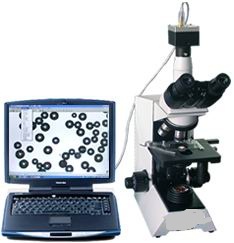Particle Analyzers
Particle Analyzers are used to determine the physical makeup of individual particulates in aerosols, dispersion, emulsions, powders, and other samples. Particle analysis is also used to determine particle velocity and surface charging. Particle velocity measurements are important in understanding spray and aerosol processes such as paint spraying, thermal spraying, powder coating, and spray dispensers. Surface charging or zeta potential is used to understand dispersion stability. Zeta potential, an important measurement taken by particle analyzers, indicates the magnitude of the repulsion or attraction between particles.
Particle analyzers may use blocking or attenuation, or diffraction or scattering techniques. Blockage or attenuation is based on a particle's ability to reduce the transmission of light, radiation (X-ray, beta) or electrical field (electrozone). In the light blockage technique, a small volume of the sample is passed between a laser light source and a detector, and the shadows cast by the particles on the detector are measured. Diffraction or scattering is most accurately called low-angle light laser scattering (LALLS). Because they are non-destructive and non-intrusive, LALLS particle analyzers are the preferred type in many different industries. Some particle analyzers use ferromagnetic techniques. Others use microscopy and image analysis. Ferrography instruments or ferrographs apply a magnetic field to a dispersion of contamination or ferromagnetic (e.g., steel, cast iron) wear particles in oil, lubricant, grease, fuel, hydraulic fluids and other fluids. A ferrogram is produced with separation of different types of particles, and then analyzed. Microscopy and image analysis techniques rely on capturing an image of the particles and then manual or automatically measuring the particles.
Particle analyzers that use image analysis methods allow automation and the capturing of thousands of particles as well as the determination of aspect ratio and other shape factors. Particle analyzers may use sedimentation or centrifugal separation, and sieving or filtration techniques. Sedimentation or centrifugal separation is the traditional method of particle analysis used in the paint and ceramics industries. This technique has limited range, however, and is poorly suited for emulsions where the material does not settle, or with very dense materials that settle too quickly. Sieving is an old fashioned method that is relatively inexpensive.
Particle analyzers that use sieving are suitable for large particles, and often found in minding and food processing applications. These particle analyzers can separate into size bands, if required. Particle analyzers may also use differential mobility analysis (DMA), electrophoretic mobility, photon correlation spectroscopy, single particle light scattering, multi-angle light scattering, single particle light obscuration, laser Doppler velocimetry (LDV), time-of-flight, fiber optic doppler anemometry (FODA), or fluorescence-activated cell sorting (FACS) techniques. Particle analyzers that use field flow fractionation (FFF), air classification, and inertial impactors are also available.
